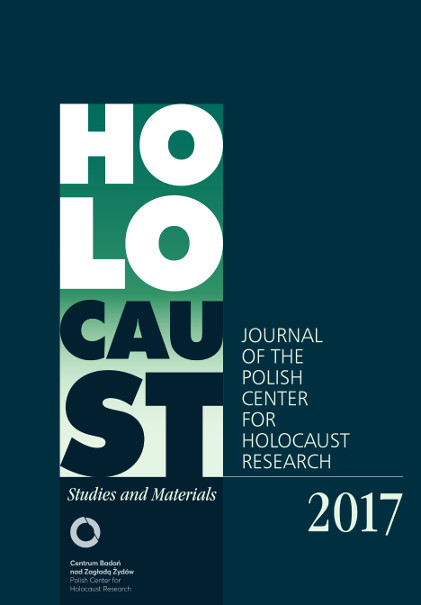Predator. The Looting Activity of Pieter Nicolaas Menten (1899–1987)
Zagłada Żydów. Studia i Materiały, No. Holocaust Studies and Materials (2017), Pages: 112-147
Submission Date: 2020-12-06Publication Date: 2017-12-06
 https://doi.org/10.32927/zzsim.712
https://doi.org/10.32927/zzsim.712
Abstract
The Nazi looting of works of art and cultural goods during 1933–1945 is usually divided into institutionalized and unauthorized, that is, wild one. The former was conducted by state and party special organizations and authorities, while the latter, widespread extensively in the east, was practiced by many Germans on their own account. The author suggests introducing a separate category of “specialized
looting”, encompassing those who engaged in looting with full awareness – on their own account and/or on commission – and who were proficient in evaluation of the artistic goods and knew where and in whose possession they could be found. In the Reich and in occupied France and Holland there were many such expert robbers. In Poland their number remained small after the initial wave of official confiscations. The most notable exception was the Dutchman, Pieter Nicolaas Menten (1899–1987), who after the war became one of the wealthiest citizens of Holland and owner of a private art collection unavailable to the public.
The scope, character, and methods of the looting conducted by Menten for his private use in Kraków and Lvov during the German occupation between early 1940 and the end of 1942 make him a very special case in the history of Nazi looting. These aspects are analyzed on the basis of extensive archival materials and evidence collected in Holland and Poland during the investigations and trials against Menten (the first one took place in the late 1940s and was followed by next ones in the late 1970s), who was accused of collaboration with the Germans and the massacre of Jewish inhabitants of the Galician villages of Urycz and Podhorodce in the summer of 1941. Menten was never sentenced for the looting of works of art in Kraków, where he was an appointed forced administrator of four Jewish artistic salons, or in Lvov, where he appropriated art collections and furnishings of several Lvov professors murdered on 4 July 1941. He was never found guilty even though when in January 1943 he left the General Government and went to Holland he took – with Himmler’s special permission – four railway carriages of valuable works of art, gold and silverware, antique furniture, and Oriental rugs. The post-war collection of works of art in Menten’s possession wasn’t liable to confiscation under Dutch law and has become dispersed.
Keywords
looting of works of art in the General Government , Jewish antique shops and artistic salons in Kraków after 1939 , occupation period art trade , murder of professors in Lvov , Schöngarth’s Einsatzgruppe zur besonderen Verwendung , Dutch Nazi , corruption in the German party apparatus and in the Security Police in the General Government , pursuit of Nazi criminals , post-war trials of perpetrators
License
Copyright (c) 2017 Author&"Holocaust Studies and Materials"

This work is licensed under a Creative Commons Attribution 4.0 International License.
https://creativecommons.org/licenses/by/4.0
The journal is published under the Diamond Open Access Standard, CC-BY-4.0 Deed - Attribution 4.0 International - Creative Commons
Most read articles by the same author(s)
- Nawojka Cieślińska-Lobkowicz, Traces of Unknown Pre-war Jewish Collectors and Owners of Works of Art , Zagłada Żydów. Studia i Materiały: No. 17 (2021)
- Nawojka Cieślińska-Lobkowicz, Polish. Jewish. ‘Post-Jewish’. Nazi Looting of Works of Art and Restitution Issues in Poland 1945‒2020 , Zagłada Żydów. Studia i Materiały: No. 16 (2020)
- Nawojka Cieślińska-Lobkowicz, The new Holocaust Museum in Amsterdam , Zagłada Żydów. Studia i Materiały: No. 20 (2024)
- Nawojka Cieślińska-Lobkowicz, Death of the Antiquarian on Chłodna Street , Zagłada Żydów. Studia i Materiały: No. 12 (2016)
- Nawojka Cieślińska-Lobkowicz, Professional Looter. On the looting activity of Pieter Nicolaas Menten (1899–1987) , Zagłada Żydów. Studia i Materiały: No. 11 (2015)
- Nawojka Cieślińska-Lobkowicz, Habent Sua Fata Libelli. Occupation-period art market in Warsaw and Jewish property , Zagłada Żydów. Studia i Materiały: No. 10 (2014)
- Nawojka Cieślińska-Lobkowicz, Jewish Biblia Pauperum , Zagłada Żydów. Studia i Materiały: No. 11 (2015)
- Nawojka Cieślińska-Lobkowicz, Losy mienia kulturalnego polskich Żydów w okresie okupacji hitlerowskiej i w pierwszych latach powojennych , Zagłada Żydów. Studia i Materiały: No. 6 (2010)
- Nawojka Cieślińska-Lobkowicz, World War II Tragedy Memorial Museum , Zagłada Żydów. Studia i Materiały: No. 13 (2017)
- Nawojka Cieślińska-Lobkowicz, On the “What We Were Unable to Shout Out to the World” Exhibition at the Jewish Historical Institute in Warsaw , Zagłada Żydów. Studia i Materiały: No. 14 (2018)
Similar Articles
- Nawojka Cieślińska-Lobkowicz, Professional Looter. On the looting activity of Pieter Nicolaas Menten (1899–1987) , Zagłada Żydów. Studia i Materiały: No. 11 (2015)
- Peter Black, The Sonderdienst in the General Government , Zagłada Żydów. Studia i Materiały: No. 12 (2016)
- Nawojka Cieślińska-Lobkowicz, Habent Sua Fata Libelli. Occupation-period art market in Warsaw and Jewish property , Zagłada Żydów. Studia i Materiały: No. 10 (2014)
- Gabriel Finder, The Trial of Shepsl Rotholc and the Politics of Retribution in the Aftermath of the Holocaust , Zagłada Żydów. Studia i Materiały: No. 2 (2006)
- Dan Michman, Dutch Society and the Jewish Fate: A Puzzling Record , Zagłada Żydów. Studia i Materiały: No. 12 (2016)
- Nawojka Cieślińska-Lobkowicz, Death of the Antiquarian on Chłodna Street , Zagłada Żydów. Studia i Materiały: No. 12 (2016)
- Nawojka Cieślińska-Lobkowicz, Traces of Unknown Pre-war Jewish Collectors and Owners of Works of Art , Zagłada Żydów. Studia i Materiały: No. 17 (2021)
- Zuzanna Schnepf-Kołacz, The Fate of Journalists of the German ‘Reptile Newspaper’ – Nowy Kurier Warszawski in the Light of Post-War Trials on the Basis of the ‘August Decree’ , Zagłada Żydów. Studia i Materiały: No. 2 (2006)
- Lars Jockheck, From Agent to Collaborator? The Collaboration of the Jewish Journalist Fritz Seifter of Bielsko with the German Authorities in the 1930s and the 1940s. , Zagłada Żydów. Studia i Materiały: No. 2 (2006)
- Klaus Peter Friedrich, Nazi Murder on the Jews in Polish Communist Press (1942–1944) , Zagłada Żydów. Studia i Materiały: No. 2 (2006)
1 2 3 4 5 6 7 8 9 10 11 12 13 14 15 16 17 18 19 20 21 22 23 24 25 26 27 28 29 30 31 32 33 34 35 36 37 38 39 40 41 42 43 44 45 46 47 48 49 50 > >>
You may also start an advanced similarity search for this article.
 English
English
 Język Polski
Język Polski



 https://orcid.org/0000-0002-8646-285X
https://orcid.org/0000-0002-8646-285X

